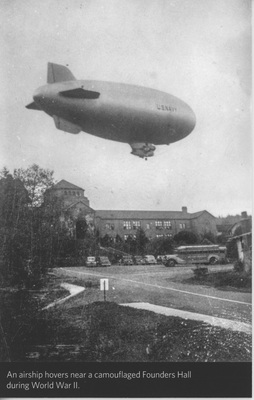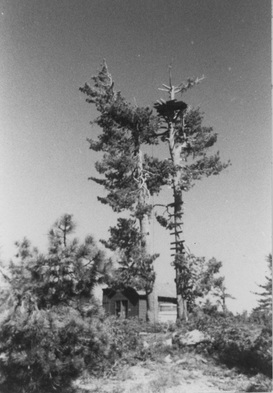Civil Defense in Humboldt County during World War II
The Humboldt County Civil Defense Council, organized quite some time before the attack on Pearl Harbor, sprang into action upon news of the Japanese assault on Hawaii. A network of 55 air raid warning posts, staffed 24 hours a day by civilian volunteers, was established to provide an early warning system for the community. Each post was equipped with state-of-the-art airplane detection instruments and a direct telephone line to an army command post. Upon detection of an air raid threat an alarm would be sounded throughout the county.
County Air Raid Wardens were appointed, and in the cities each block had a Defense Captain who initially checked each house for light leaks and would check again when blackout sirens were sounded. Due to the close proximity to the Pacific, blackouts in coastal communities such as Ferndale, Eureka, Samoa, and Trinidad were seen as a crucial step to avoid air attacks along the Humboldt coastline. All windows in houses were ordered to be covered or “blacked out,” with only a small light permitted in each residence or place of business. Street lights which faced the sea were painted black, and motorists were only allowed to turn on parking lights while driving.
The first blackout in the region was ordered by the Humboldt Bay Navy Section Base in Samoa on December 8, 1941, the day after the Pearl Harbor incident. False reports of enemy planes sighted heading north over San Francisco triggered the blackout order. Enemy planes were also falsely reported to be spotted over the Eel River Valley and off of Cape Mendocino. When the perceived danger had passed the all-clear signal, four blasts of equal length, was sounded.
Rationing was also an important part of Civil Defense during World War II, and Humboldt County was no exception. Rationed items included sugar, coffee, meat products, tires, shoes and gasoline, but the salvage of household byproducts such as fats and scrap metal was also important to Home Front efforts. From 1942 to 1945, the government issued rationing books and stamps to those who registered their families with the local Civil defense Council. Ration coupons, which were distributed by volunteers at local school sites, were allocated based on family size. Coupons were printed with a point value in two different colors: red coupons were redeemed for meats, cheeses and oils and blue points were earmarked for canned foods. Meat for pets was not provided for in ration books.
There were some foods that remained unrationed, including whale meat, which Humboldt County citizens consumed in large amounts during the war. Other unrationed foods included turkey and fish.
Gasoline was also closely rationed, prompting many carpools and encouraging many to become pedestrians during the war. Similarly to food ration coupons, gasoline rationing coupons were distributed at schools. Depending on their level of importance to the war and civil defense effort, “A” and “B” coupons were issued. “B” coupon recipients were limited to three gallons of gas per month.
County Air Raid Wardens were appointed, and in the cities each block had a Defense Captain who initially checked each house for light leaks and would check again when blackout sirens were sounded. Due to the close proximity to the Pacific, blackouts in coastal communities such as Ferndale, Eureka, Samoa, and Trinidad were seen as a crucial step to avoid air attacks along the Humboldt coastline. All windows in houses were ordered to be covered or “blacked out,” with only a small light permitted in each residence or place of business. Street lights which faced the sea were painted black, and motorists were only allowed to turn on parking lights while driving.
The first blackout in the region was ordered by the Humboldt Bay Navy Section Base in Samoa on December 8, 1941, the day after the Pearl Harbor incident. False reports of enemy planes sighted heading north over San Francisco triggered the blackout order. Enemy planes were also falsely reported to be spotted over the Eel River Valley and off of Cape Mendocino. When the perceived danger had passed the all-clear signal, four blasts of equal length, was sounded.
Rationing was also an important part of Civil Defense during World War II, and Humboldt County was no exception. Rationed items included sugar, coffee, meat products, tires, shoes and gasoline, but the salvage of household byproducts such as fats and scrap metal was also important to Home Front efforts. From 1942 to 1945, the government issued rationing books and stamps to those who registered their families with the local Civil defense Council. Ration coupons, which were distributed by volunteers at local school sites, were allocated based on family size. Coupons were printed with a point value in two different colors: red coupons were redeemed for meats, cheeses and oils and blue points were earmarked for canned foods. Meat for pets was not provided for in ration books.
There were some foods that remained unrationed, including whale meat, which Humboldt County citizens consumed in large amounts during the war. Other unrationed foods included turkey and fish.
Gasoline was also closely rationed, prompting many carpools and encouraging many to become pedestrians during the war. Similarly to food ration coupons, gasoline rationing coupons were distributed at schools. Depending on their level of importance to the war and civil defense effort, “A” and “B” coupons were issued. “B” coupon recipients were limited to three gallons of gas per month.


